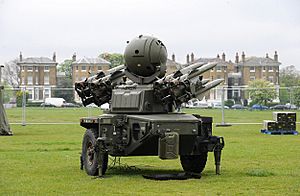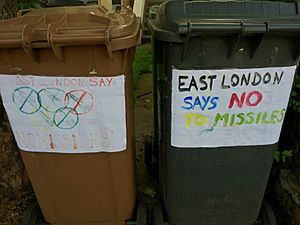Security for the 2012 Summer Olympics facts for kids
The 2012 Summer Olympics in London needed a huge security plan. This was to keep everyone safe during the big event. Police led most of the security, with 13,000 officers ready to help. They also had support from 17,000 members of the armed forces.
The Royal Navy, Army, and Royal Air Force (RAF) all played a part. They used ships in the River Thames, fast Typhoon jets, and special radars. Even helicopter snipers and surface-to-air missiles were ready. This big security effort was called Operation Olympics. It cost about £553 million to make sure everything was secure.
Part of the money for venue security came from the London Organising Committee of the Olympic and Paralympic Games (LOCOG). A private security company called G4S was supposed to provide many staff. However, they had problems training enough people. They only provided about 10,000 staff instead of the 13,700 they promised.
This was the biggest security operation Britain had seen in many years. A total of 40,000 security people were involved. This high level of security was partly because of a terrorist attack in London on 7 July 2005. This happened just one day after London was chosen to host the Olympics.
Contents
Protecting the Skies: Air Defences
The plan for air security was very detailed. It aimed to stop any air threats to the Games. This included everything from large airliners to small drones. Special rules were made for the airspace over London. Only planes with special permission could enter.
The RAF was in charge of air security. They used their existing air defence systems. A key part of the plan was having RAF Eurofighter Typhoon fighter jets ready. These jets were based at RAF Northolt in West London. They could react very quickly to any danger.
Another layer of defence involved RAF Regiment snipers. They would target small, slow flying objects. These snipers were carried by RAF Puma helicopters. Royal Navy and Army Lynx helicopters also helped. They operated from HMS Ocean, a large ship docked in the River Thames.
Six sites around London were chosen for missile units. Four sites used Rapier missiles, and two used Starstreak missiles. The British government confirmed these missiles would be deployed from mid-July.
Early Warning Systems
Air traffic control and defence radars helped manage the airspace. They gave early warnings of any threats. Mobile radars were also used, including special ground-based radars from the RAF. Large RAF Sentry AWACS aircraft also provided early warning. Royal Navy Sea King ASACS helicopters helped too.
Soldiers from the Royal Artillery were also positioned at 28 spots around London. They had binoculars and special devices to spot and report any unusual activity in the sky.
Rapier Missile Sites
Rapier missiles are designed to shoot down aircraft. They are short-range air defence systems. Each system has eight missiles, along with tracking and surveillance radars. There were four Rapier sites in total. Two were in north London and two in south London.
The Rapier missile sites were:
- Blackheath Common
- Oxleas Wood, Eltham
- William Girling Reservoir, Enfield
- Barn Hill, Netherstone Farm, near Epping Forest
Starstreak Missile Sites
Two sites were chosen for Starstreak missiles. These were on top of tall buildings closer to the Olympic Stadium. One site was a water tower converted into flats in Bow. The other was a 15-storey block of council flats in Leytonstone. Residents of the Leytonstone building tried to stop the missiles from being placed there. However, they lost their court case in July 2012.
The Starstreak missile sites were:
- Lexington Building, Bow Quarter in LB Tower Hamlets
- Fred Wigg Tower in Leytonstone, LB Waltham Forest
Practice Drills
A large training exercise took place from 2 to 10 May 2012. It was called Exercise Olympic Guardian. This exercise tested all the air defences. It involved Sentry aircraft, VC-10 tanker planes, and Typhoon jets. The Typhoon jets operated from RAF Northolt. This was the first time fighter aircraft had been based there since the Second World War.
From 14 July 2012, the Royal Air Force, Army, and Navy began enforcing a 30-mile exclusion zone. This zone covered London and other areas. No unauthorized aircraft could enter this space.
Air Security Equipment Used
The following equipment was used for air security:
- 3 x Westland Sea King helicopters
- Westland Puma helicopters, based in Ilford, East London
- Westland Lynx helicopters operating from the helicopter carrier HMS Ocean
- Sentry AEW1 (AWACS) aircraft from RAF Waddington
- 4 x Typhoon FGR4 multirole fighters based at RAF Northolt, West London
- Starstreak surface-to-air missile systems
- Rapier surface-to-air missile systems
Protecting the Waters: Maritime Defences
The Royal Navy and Royal Marines also had a role in security. They used a device called the Long Range Acoustic Device (LRAD). This device uses sound. It was placed on a landing craft on the Thames near Westminster. It was mainly used as a loud-hailer to give instructions. Royal Marines also operated small boats from HMS Ocean. These boats carried regular weapons.
The following naval equipment was used:
- The helicopter carrier HMS Ocean based in the Thames
- The landing platform dock HMS Bulwark off the Dorset coast
- The landing ship dock RFA Mounts Bay based in Weymouth Bay
- Patrol boats
- Rigid Raiders (small, fast boats)
Keeping Computers Safe: IT Security
BT was in charge of the computer systems for the Olympics. They had to protect the network from online attacks. BT expected many complex attacks. However, they found that most attacks were simple. They seemed to be done by children.
BT staff watched social media and chat sites for clues about future attacks. They even saw one person stop planning an attack because their mom called them for dinner! Another person defended their hacking skills by saying, "what do you expect, I’m only 12?"
Another challenge was giving over 25,000 journalists access to the network. Many of their computers had viruses or other harmful software. This caused a lot of unwanted emails (spam) to be sent from BT's network. BT had to explain this to companies that block spam.
Security Staff Shortages
Just a few months before the Games, a problem came up with G4S. This was the company hired to provide security staff. They could not train enough people. Because of this, an extra 3,500 sailors, soldiers, and airmen were assigned to security duties.
Lord Coe, who was in charge of LOCOG, said that the security of the Olympics was not put at risk.
Unusual Incidents
A few months before the Games, a man named Michael Shrimpton contacted authorities. He warned them about a possible attack on the Games. He claimed that a German intelligence agency had stolen a nuclear warhead. He said they planned to detonate it during the opening ceremony.
Police took his report seriously. When they found out it was a hoax, he was arrested. He was later found guilty of spreading false information. He was sentenced to twelve months in prison.




